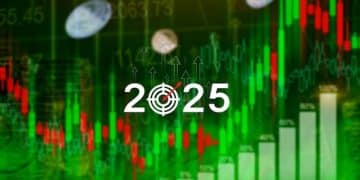2.8% GDP Growth 2025: Impact on Your Investments

The projected 2.8% GDP growth in 2025 is expected to foster a dynamic economic environment, influencing investment strategies across various sectors through increased corporate earnings, sustained employment, and potential shifts in monetary policy.
As we look ahead, the economic landscape of 2025 is drawing significant attention, particularly with a projected 2.8% GDP growth. This forecast isn’t just a number; it represents a powerful current that can either carry your investments to new heights or expose them to unforeseen risks. Understanding how this anticipated economic expansion might shape various market segments is crucial for any investor looking to strategically position their portfolio.
Understanding the Mechanics of GDP Growth
Gross Domestic Product (GDP) is the total monetary or market value of all the finished goods and services produced within a country’s borders in a specific time period. It serves as a comprehensive scorecard of a country’s economic health, reflecting its overall productivity and living standards. A projected 2.8% growth rate in 2025, while moderate, signals a healthy expansion, suggesting an economy that is steadily recovering or building momentum without overheating.
When GDP grows, it generally translates into a more robust economic environment. This growth typically originates from several key components: increased consumer spending, higher business investment, government expenditure, and net exports. Each of these elements plays a vital role in propelling the economy forward and, consequently, shaping the landscape for various asset classes.
Consumer Spending and its Ripple Effect
A significant portion of GDP in the US is driven by consumer spending. As the economy expands, employment levels typically rise, wages tend to increase, and consumer confidence strengthens. This positive feedback loop encourages households to spend more on goods and services, ranging from daily necessities to large discretionary purchases. This increased demand directly benefits companies in the retail, consumer discretionary, and services sectors.
- Retail Sector: Enhanced consumer purchasing power typically boosts sales for retailers, from e-commerce giants to brick-and-mortar stores.
- Hospitality and Travel: Discretionary spending often translates into increased demand for experiences, benefiting airlines, hotels, and entertainment venues.
- Automotive Industry: Higher consumer confidence can lead to increased sales of new and used vehicles.
Moreover, robust consumer spending can create a ripple effect, encouraging businesses to invest more in production capacity, technology, and hiring. This cycle is a cornerstone of sustained economic growth and directly impacts corporate earnings, which are a primary driver of stock market performance. Investors should therefore analyze sectors with high exposure to consumer demand.
Understanding the interplay between these components is critical. A 2.8% GDP growth suggests that, while not a boom, the fundamental engines of the economy are working effectively. This environment generally favors equities, as corporate profits stand to benefit from increased economic activity. It also implies a relatively stable job market, which further supports consumer confidence and spending capability.
Monetary Policy and Inflationary Pressures
The Federal Reserve closely monitors economic indicators like GDP growth and inflation when formulating monetary policy. A 2.8% GDP growth rate suggests an economy that is expanding at a manageable pace, which might influence the central bank’s stance on interest rates. If this growth is coupled with contained inflation, the Fed might maintain a stable monetary policy, providing a predictable environment for investors.
However, if the growth trajectory begins to accelerate significantly or if inflationary pressures emerge, the Fed might consider tightening monetary policy by raising interest rates. Such actions are designed to cool down an overheating economy and curb inflation, but they can also impact borrowing costs for businesses and consumers, potentially slowing down economic activity and affecting certain investment sectors more than others.

Interest Rates and Fixed Income Investments
Interest rate decisions have a direct and inverse relationship with the bond market. When interest rates rise, newly issued bonds offer higher yields, making older, lower-yielding bonds less attractive. This typically causes the prices of existing bonds to fall. Conversely, if interest rates are expected to remain stable or decline, bond prices may rise. For investors in fixed income, therefore, the outlook for Fed policy is paramount.
- Short-term Bonds: Generally less sensitive to interest rate changes compared to long-term bonds.
- Long-term Bonds: More susceptible to interest rate fluctuations, offering higher yields but also greater price volatility.
- Inflation-Indexed Securities: Treasury Inflation-Protected Securities (TIPS) are designed to protect against inflation, adjusting their principal value with the Consumer Price Index (CPI).
A 2.8% GDP growth could lead to increased inflation if demand outstrips supply, which would then encourage the Fed to tighten. Conversely, if inflation remains benign despite growth, the Fed might maintain a more dovish stance. Investors should consider shifting portfolios to potentially benefit from rising rates (e.g., short-duration bonds or floating-rate notes) or protection against inflation if it becomes a concern.
Moreover, the anticipated GDP growth will also provide signals regarding the strength of the US dollar. A strong economy often leads to a stronger currency, which can have implications for international investments and the cost of imports and exports. Therefore, monitoring inflation data alongside growth projections is crucial for making informed decisions within your investment portfolio, particularly in fixed income instruments.
Corporate Earnings and Equity Markets
A 2.8% GDP growth is a strong indicator of a healthy operating environment for businesses, which generally translates into stronger corporate earnings. As the economy expands, companies experience increased sales volumes, potentially higher pricing power, and improved profitability. These factors are typically positive for equity markets, acting as a tailwind that can support higher stock valuations.
However, not all sectors benefit equally. Growth often favors cyclical industries that are closely tied to the economic cycle, such as technology, industrials, and consumer discretionary sectors. Companies in these areas are more sensitive to economic expansion, as demand for their products and services tends to increase significantly during periods of growth. Investors should conduct thorough research to identify companies with strong fundamentals and sustainable competitive advantages within these growth sectors.
Identifying Winning Sectors
While broad market indices may perform well, a discerning investor will seek out specific sectors and companies poised for outperformance. Strong GDP growth can provide a fertile ground for innovation and expansion.
- Technology: Continued demand for digital transformation, cloud computing, and AI technologies.
- Healthcare: Aging populations and advancements in medical technology provide steady growth, often less cyclical.
- Industrials: Increased business investment and infrastructure spending can boost demand for industrial goods and services.
Furthermore, analysts will be closely scrutinizing earnings reports and company guidance for 2025, looking for confirmation that the macroeconomic growth is translating into tangible financial results. Companies that can consistently demonstrate earnings growth above the broader market average are often rewarded with higher stock prices. Conversely, those that fail to meet expectations, even in a growing economy, may face downward pressure.
The forward-looking nature of equity markets means that projections for 2025 GDP growth are likely already partially priced into current valuations. However, sustained economic expansion can continue to fuel positive sentiment and further gains. Investors must balance optimism with a realistic assessment of individual company prospects, considering valuation multiples and growth potential relative to the overall market and their personal risk tolerance.
Real Estate and Alternative Investments
The impact of 2.8% GDP growth on real estate and alternative investments is multifaceted and often tied to underlying economic conditions and investor sentiment. In real estate, sustained economic expansion generally leads to increased demand for both commercial and residential properties. Higher employment and wages mean more individuals can afford to rent or purchase homes, driving up housing prices and rental rates. For commercial real estate, growing businesses require more office space, retail locations, and industrial facilities, which positively impacts property values and rental income.
Alternative investments, which include diverse assets like private equity, venture capital, commodities, and hedge funds, also react to economic growth, albeit in varied ways. Private equity and venture capital funds often thrive in growth environments, as expanding companies present more opportunities for investment and successful exits through IPOs or acquisitions. However, the specific dynamics depend heavily on the sub-category of the alternative asset and the broader investment landscape.
Real Estate Market Dynamics
A growing economy can inject vitality into various segments of the real estate market. The stability and growth associated with a 2.8% GDP increase can enhance investor confidence, spurring both domestic and foreign investment in properties.
- Residential: Strong employment and wage growth tend to boost home sales and rental demand, particularly in urban and growing suburban areas.
- Commercial: Increased business activity requires more office, retail, and industrial spaces, driving up occupancy rates and rental yields.
- REITs (Real Estate Investment Trusts): These publicly traded entities that own income-producing real estate can offer exposure to property markets without direct ownership, benefiting from rising property values and rental income.
However, investors must also consider potential headwinds, such as rising interest rates, which can increase borrowing costs for real estate developers and buyers, potentially cooling off market activity. Supply chain issues and construction costs can also influence profitability and development. Careful due diligence is essential, focusing on specific property types and geographic markets that are best positioned to benefit from the projected economic expansion.
For alternative investments, commodities like oil and industrial metals tend to perform well during periods of strong economic growth due to increased industrial demand. Hedge funds, with their diverse strategies, may find additional opportunities in volatile markets or in specific sectors that are experiencing rapid transformation. Therefore, investors with a larger risk appetite may explore these avenues as part of a diversified portfolio, seeking exposure beyond traditional stocks and bonds.
Global Economic Interconnections and Trade Outlook
The US economy does not operate in a vacuum; its performance, particularly a projected 2.8% GDP growth in 2025, has significant implications for global markets and trade. International trade relationships mean that the economic health of the US can influence, and be influenced by, the prosperity of its major trading partners. A robust US economy typically translates into increased demand for imported goods and services, benefiting exporting nations.
This interconnectedness means that investors with international holdings or those concerned with global macroeconomic trends must consider how a growing US economy might fuel or dampen growth abroad. For instance, countries heavily reliant on exporting to the US may see their own economies strengthen, potentially boosting their equity markets and currencies. Conversely, a stronger US dollar, often a byproduct of robust US growth, could make US exports more expensive, affecting the competitiveness of American companies in global markets.
Trade Balances and Currency Movements
The dynamics of trade balances and currency exchange rates are crucial considerations in a globally interconnected economy. A significant increase in US imports due to domestic demand can lead to a larger trade deficit, while a stronger dollar can further influence these dynamics.
- Emerging Markets: Often benefit from increased US demand for goods, but can face capital outflows if US interest rates rise.
- Developed Economies: Will likely see increased export opportunities to the US, but might also face competitive pressures from a strong dollar.
- Currency Investors: Should monitor interest rate differentials and trade data to predict currency movements, which impact returns on foreign investments.
Furthermore, geopolitical events and international trade agreements will continue to play a significant role in shaping the global economic outlook. Even with strong domestic growth, external shocks or policy changes in other major economies could introduce volatility. Therefore, a diversified international portfolio requires a keen understanding of these intricate relationships. Investors should consider the potential for growth in other industrialized nations and emerging markets, and how their economies might react to the US’s projected 2.8% GDP expansion, seeking to identify complementary or counter-cyclical assets to balance their overall risk exposure and maximize potential returns.
Risk Management and Portfolio Diversification Strategies
Even with a projected 2.8% GDP growth, no economic forecast is without potential risks. Unexpected events, such as geopolitical conflicts, natural disasters, or unforeseen shifts in global supply chains, can disrupt even the most positive economic trajectories. For investors, this underscores the timeless importance of risk management and portfolio diversification. While growth is anticipated, prudent investing always involves preparing for a range of outcomes rather than relying solely on a single forecast.
Diversification, the practice of spreading investments across various asset classes, sectors, and geographical regions, is crucial in mitigating idiosyncratic risks. A diversified portfolio can help cushion the impact of a downturn in any single area, ensuring that overall returns remain more stable. Moreover, understanding personal risk tolerance and investment objectives is paramount. What might be an appropriate strategy for a younger investor with a long time horizon may not be suitable for someone approaching retirement.

Essential Diversification Principles
Successful diversification isn’t just about holding multiple assets; it’s about holding assets that respond differently to various market conditions, ensuring a more resilient portfolio.
- Asset Allocation: Spreading investments across stocks, bonds, cash, and alternative assets based on risk tolerance and financial goals.
- Sector Diversification: Investing in different industries to avoid overexposure to any single economic segment.
- Geographic Diversification: Including international investments to reduce dependence on a single national economy.
Investors should regularly review and rebalance their portfolios to ensure they remain aligned with their initial objectives and current market conditions. This proactive approach helps to capitalize on opportunities that arise from economic shifts and to protect against potential downturns. Furthermore, having an emergency fund and maintaining a long-term perspective are vital components of a robust investment strategy, particularly when navigating periods of forecasted economic growth, which can sometimes lead to excessive optimism.
The 2.8% GDP growth outlook for 2025 offers a positive backdrop, but it should serve as a foundation for informed decisions, not as a guarantee. By practicing diligent risk management, maintaining a diversified portfolio, and staying attentive to both micro and macroeconomic signals, investors can best position themselves to navigate the economic landscape of 2025 and beyond effectively. Staying informed and adaptable are key virtues in ever-evolving financial markets.
Strategic Investment Adjustments for 2025
Given the projected 2.8% GDP growth in 2025, investors have a window of opportunity to make strategic adjustments to their portfolios. This involves not only identifying potential growth areas but also reinforcing positions in sectors known for stability or defensive characteristics. The goal is to maximize returns while effectively managing the inherent risks associated with economic shifts. Understanding which sectors are likely to outperform and why, provides a significant advantage.
For instance, sectors like technology, consumer discretionary, and financials often thrive in periods of moderate economic expansion. Technology companies benefit from increased business investment and consumer demand for innovation, while consumer discretionary firms see higher sales as incomes rise. Financial institutions typically experience improved lending conditions and profitability. However, simply investing in these broad categories might not be enough; a deeper dive into sub-sectors and individual companies is often warranted to uncover the most promising opportunities with strong fundamentals and clear growth trajectories.
Optimizing Your Portfolio Posture
Making informed adjustments requires a balanced approach, considering both offensive and defensive strategies to cater to various market conditions that might arise even within a growth environment.
- Growth Stocks: Focus on companies with strong earnings growth potential, innovative products, and expanding market shares in key sectors.
- Value Stocks: Consider undervalued companies that may benefit from a broader economic uplift as their depressed valuations normalize.
- Defensive Plays: Maintain positions in stable sectors like utilities, healthcare (non-cyclical), and consumer staples for portfolio stability against potential volatility.
Additionally, investors should consider the role of dividend-paying stocks. While growth stocks may offer higher capital appreciation potential, dividend stocks can provide a steady stream of income, especially valuable during periods of market uncertainty or slower growth. The ideal strategy often involves a careful blend of both, tailored to individual financial goals and risk tolerance. Rebalancing your asset allocation periodically ensures that your portfolio remains aligned with your long-term objectives and adapted to the evolving economic landscape of 2025.
Staying informed about economic reports, company earnings, and central bank communications will be paramount. The projected 2.8% GDP growth provides a strong foundation, but market dynamics are fluid. Adapting your investment strategy to new information and maintaining a diversified portfolio will be key to navigating 2025 successfully, aiming for both capital appreciation and portfolio resilience in the face of changing economic winds.
| Key Aspect | Brief Description |
|---|---|
| 📊 GDP Growth Impact | A 2.8% GDP growth drives corporate earnings, employment, and shapes monetary policy. |
| 📈 Equity Opportunities | Favors cyclical sectors like technology, industrials, and discretionary consumer goods. |
| 🛡️ Risk & Diversification | Essential due to potential external shocks and market volatility; reassess risk tolerance. |
| 🌐 Global Connections | Impacts international trade, currency values, and foreign investment dynamics. |
Frequently Asked Questions About 2025 GDP Growth and Investments
A 2.8% GDP growth rate indicates a healthy, steady expansion of the economy. It suggests a balance between robust activity and avoiding overheating, leading to sustained job growth, increased consumer spending, and positive corporate earnings. This environment is generally favorable for long-term economic stability and investment opportunities across various sectors.
Sectors that are typically cyclical and sensitive to economic expansion are likely to benefit most. These include technology, consumer discretionary (e.g., retail, travel), industrials, and financials. Increased consumer confidence and business investment directly fuel these sectors, leading to higher revenues and profitability. Healthcare and utilities may offer stability but not always the highest growth during such periods.
The Federal Reserve monitors GDP growth closely. If 2.8% growth is accompanied by contained inflation, interest rates might remain stable. However, if this growth sparks inflationary pressures, the Fed could consider rate hikes to temper the economy. Investors in fixed income should be prepared for potential shifts based on the inflation outlook, as rising rates typically depress bond prices.
Despite positive GDP projections, potential risks include unexpected geopolitical events, supply chain disruptions, commodity price volatility, and shifts in global trade policies. Additionally, persistent inflation could trigger aggressive monetary tightening, which might slow growth. Investors should maintain a diversified portfolio and regularly assess their risk exposure to mitigate the impact of unforeseen adverse developments.
While the 2025 GDP forecast is an important data point, significant adjustments to a long-term investment strategy should be based on your overall financial goals, time horizon, and risk tolerance, not solely on a single year’s projection. Use the forecast to inform tactical adjustments within your broader strategy, focusing on diversification and periodic rebalancing to align with current market realities.
Conclusion
The projected 2.8% GDP growth in 2025 offers a compelling backdrop for investors, signaling a robust and expanding economy. This growth trajectory paves the way for opportunities across various sectors, from technology and consumer discretionary to real estate, driven by enhanced corporate earnings, strong employment, and increased consumer confidence. However, navigating this landscape effectively demands more than just embracing the positive outlook; it requires a strategic, informed, and adaptable approach to your investment portfolio. Understanding the interplay between economic growth, monetary policy, and global interconnections is crucial. By prioritizing risk management, maintaining thoughtful diversification, and continuously monitoring market signals, investors can position themselves not only to capitalize on the anticipated growth but also to build resilience against potential economic shifts. The key to successful investing in 2025 will be a blend of optimism, careful analysis, and strategic agility, ensuring your investments are aligned with the dynamic forces shaping the future economy.





